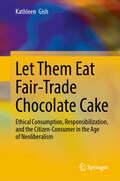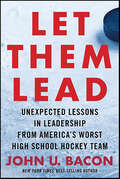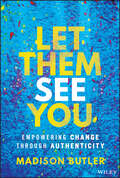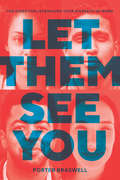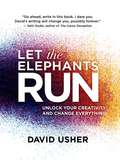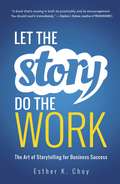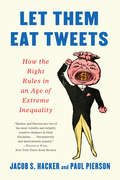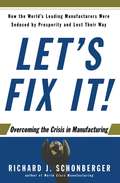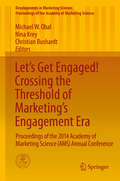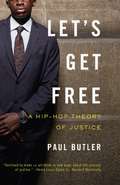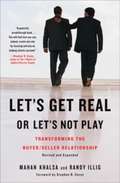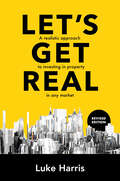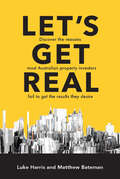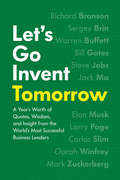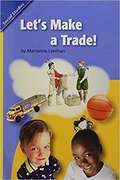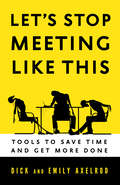- Table View
- List View
Let My People Go Surfing
by Yvon ChouinardIn his long-awaited memoir, Yvon Chouinard-legendary climber, businessman, environmentalist, and founder of Patagonia, Inc. -shares the persistence and courage that have gone into being head of one of the most respected and environmentally responsible companies on earth. From his youth as the son of a French Canadian blacksmith to the thrilling, ambitious climbing expeditions that inspired his innovative designs for the sport's equipment, Let My People Go Surfing is the story of a man who brought doing good and having grand adventures into the heart of his business life-a book that will deeply affect entrepreneurs and outdoor enthusiasts alike. .
Let My People Go Surfing
by Yvon ChouinardIn his long-awaited memoir, Yvon Chouinard-legendary climber, businessman, environmentalist, and founder of Patagonia, Inc.-shares the persistence and courage that have gone into being head of one of the most respected and environmentally responsible companies on earth. From his youth as the son of a French Canadian blacksmith to the thrilling, ambitious climbing expeditions that inspired his innovative designs for the sport's equipment, Let My People Go Surfing is the story of a man who brought doing good and having grand adventures into the heart of his business life-a book that will deeply affect entrepreneurs and outdoor enthusiasts alike.
Let My People Go Surfing: The Education of a Reluctant Businessman--Including 10 More Years of Business Unusual
by Naomi Klein Yvon ChouinardIn his long-awaited memoir, Yvon Chouinard-legendary climber, businessman, environmentalist, and founder of Patagonia, Inc.-shares the persistence and courage that have gone into being head of one of the most respected and environmentally responsible companies on earth. From his youth as the son of a French Canadian blacksmith to the thrilling, ambitious climbing expeditions that inspired his innovative designs for the sport's equipment, Let My People Go Surfing is the story of a man who brought doing good and having grand adventures into the heart of his business life-a book that will deeply affect entrepreneurs and outdoor enthusiasts alike.From the Trade Paperback edition.
Let Them Eat Fair-Trade Chocolate Cake: Ethical Consumption, Responsibilization, and the Citizen-Consumer in the Age of Neoliberalism
by Kathleen GishNeoliberalism is a politico-economic framework that emphasizes deregulation, free trade, and minimal government intervention in the economy; further, it suggests that social issues are best addressed through market mechanisms. Responsibilization occurs when individuals internalize responsibility for addressing problems caused by large social structures, and is a salient instrument in the inculcation of neoliberal ideology. This monograph examines ethical consumption within the context of cultural neoliberalism. Using a qualitative approach, the book is organized around a series of interviews with self-identified ethical consumers and their experiences of responsibilization. The chapters explore the spaces in which these consumers deploy their efforts, the ways they attempt to shape the market through their economic agency, the ideologies that inform their approach, and the way they conceptualize their own identities as ethical consumers. Revealing the dilemmas intrinsic in the undertaking of ethical consumption, including instances of role strain, role conflict, and the frustration and sense of futility consumers can feel in the face of the global capitalist juggernaut, this volume provides a nuanced view of the behavior of the ethical consumer. As such, it will be of interest to researchers and students across the disciplines of economics, sociology, politics, and business.
Let Them Lead: Unexpected Lessons in Leadership from America's Worst High School Hockey Team
by John U. BaconAn uplifting leadership book about a coach who helped transform the nation&’s worst high school hockey team into one of the best. Bacon&’s strategy is straightforward: set high expectations, make them accountable to each other, and inspire them all to lead their team. When John U. Bacon played for the Ann Arbor Huron High School River Rats, he never scored a goal. Yet somehow, years later he found himself leading his alma mater&’s downtrodden program. How bad? The team hadn&’t won a game in over a year, making them the nation&’s worst squad—a fact they celebrated. With almost everyone expecting more failure, Bacon made it special to play for Huron by making it hard, which inspired the players to excel. Then he defied conventional wisdom again by putting the players in charge of team discipline, goal-setting, and even decision-making – and it worked. In just three seasons the River Rats bypassed 95-percent of the nation&’s teams. A true story filled with unforgettable characters, stories, and lessons that apply to organizations everywhere, Let Them Lead includes the leader&’s mistakes and the reactions of the players, who have since achieved great success as leaders themselves. Let Them Lead is a fast-paced, feel-good book that leaders of all kinds can embrace to motivate their teams to work harder, work together, and take responsibility for their own success.
Let Them See You: Empowering Change Through Authenticity
by Madison ButlerA deeply insightful and hands-on treatment of authenticity in the workplace and in the community In Let Them See You: Empowering Change Through Authenticity, mental health advocate and People Operations expert Madison Butler delivers an eye-opening and practical playbook for what it means to create safe spaces not just for others, but for yourself. You’ll learn what authenticity really looks like as you discover how to be authentic with yourself and with the world around you. The author will help you uncover who you are, and what you need in order to be safe space first to yourself and then to others. The book walks you through the micro- and macro-traumas that impact how you show up at home, at work, in your community, and everywhere else, every day. It unpacks the heartbreak, fear, and trauma experienced by members of every community, and gives you strategies for understanding people as they really are, bruises and all. Inside the book: A realistic and empathetic look at authenticity that takes into account the complexity of the human experience Strategies for acknowledging the myriad experiences, viewpoints, and perspectives of all people A focus on reality over unwarranted what it means to acknowledge your reality, while still speaking kindly to yourself. Perfect for managers, business leaders, and people in general, Let Them See You is a can’t-miss book for human resources practitioners, managers, business owners, and anyone else with an interest in enriching their understanding of what it means to demonstrate—and appreciate—authenticity.
Let Them See You: The Guide for Leveraging Your Diversity at Work
by Porter BraswellThe guide to getting hired, being promoted, and thriving professionally for the 40 million people of color in the workplace—from the CEO and cofounder of Jopwell, the leading career advancement platform for Black, Latinx, and Native American students and professionals. Let Them See You is a collection of Braswell’s straight-talking advice and mentorship for diverse careerists, from college students to mid-level professionals. It’s also an invitation for diversity champions to listen in on the guidance and perspective Braswell provides, particularly for young diverse workers—the population that will make up the majority of the US workforce by 2030. In Let Them See You, Braswell briefly chronicles how the majority-culture workplace evolved and why it’s a business imperative to have a more diverse workforce, and then explains how you can: · overcome not-so-invisible obstacles · create perceived value · get recognition · be true to yourself at work · build a personal brand · harness fear of failure · embrace uncomfortable conversations, and · drive diversity and inclusion, whether you’re entry-level or in management In essence, Braswell delivers all the context, tactics, and language you need to let them see you.
Let Workers Work: The Downsides of Having People Manage Their Own Benefits
by Jeffrey PfefferFacing growing competition and financial pressure, many companies have responded by moving towards increasing employees' responsibility for their own benefits management. This chapter addresses the implications of companies' haste to cut short-term visible costs and transfer decision making to the workforce for their profitability and productivity.
Let Your Life Speak: Listening for the Voice of Vocation
by Parker J. PalmerThe 25th Anniversary Edition of a modern classic, with a new Introduction by its celebrated author “Is the life I am living the same as the life that wants to live in me?” With this searching question, bestselling author Parker J. Palmer begins his insightful and moving meditation on finding our way toward meaning and purpose. As readers of many ages, backgrounds and walks of life will attest, Let Your Life Speak is an elegant and openhearted gift to all who seek to live authentically. We find a path that's right for us by embracing what gives us life and rejecting what diminishes us, listening more closely to the voice of “true self” than to what others expect or demand of us. As we live more deeply into our own identity and integrity, we find both personal fulfillment and our place in the community to which we belong. As always, Palmer writes honestly and vulnerably about his own life, including the fumbles and failures that have marked his unconventional vocational journey. He chronicles his deep dives into depression, and his quest for “an undivided life” that would allow him to offer his best gifts to the world. The details of his story are unique, but the insights he draws from it are universal. Let Your Life Speak offers no simplistic formulas for finding a meaningful path through life's complexities. Instead, it offers real-life experience, thoughtfully mined for insight and wisdom: Learn how to listen to your inner teacher and follow its guidance toward a sense of meaning and purpose Reframe your life as a series of “experiments with truth,” learning from those that fail as well as those that work Understand that the doors that close behind you can offer as much guidance as those that open up Gain inspiration and resolve from the lives of seekers who have walked this path before you Enjoy the wisdom, compassion, gentle humor and companionship of a master teacher in a beloved book that has helped hundreds of thousands of people find their way toward meaning and purpose.
Let the Eastern Bastards Freeze in the Dark: The West Versus the Rest Since Confederation
by Mary JaniganThe oil sands. Global warming. The National Energy Program. Though these seem like modern Canadian subjects, author Mary Janigan reveals them to be a legacy of longstanding regional rivalry. Something of a "Third Solitude" since entering Confederation, the West has long been overshadowed by Canada's other great national debate: but as the conflict over natural resources and their effect on climate change heats up, 150 years of antipathy are coming to a head. Janigan takes readers back to a pivotal moment in 1918, when Canada's western premiers descended on Ottawa determined to control their own future--and as Margaret MacMillan did in Paris 1919, she deftly illustrates how the results reverberate to this day.
Let the Elephants Run: Unlock Your Creativity and Change Everything
by David UsherA national bestseller, Let the Elephants Run is the essential guidebook for anyone looking to reignite their creativity.Creativity is in everyone’s DNA, not a select few. Award-winning musician and founder of CloudID Creativity Lab David Usher believes we just need the right tools to help us reconnect with our imaginations in our day-to-day lives, whether in the head office, the home office, or the artist’s studio. Using a mix of personal anecdotes and professional examples from the worlds of industry, technology, science, music, and art, he shows us that creativity is not magic; it is a learnable skill that any person or business can master. The dynamic full-colour design includes photographs, artwork, and illustrations, as well as action pages to help readers start cultivating the habit of documenting their ideas for future execution. Based on his wildly popular speaking engagements, Let the Elephants Run is the essential guidebook to reigniting and nurturing our creativity in accessible and productive ways.
Let the Story Do the Work: The Art of Storytelling for Business Success
by Esther ChoyPeople forget facts, but they never forget a good story. Let the Story Do the Work shows how the art of storytelling is key for any business to achieve success.For most, there&’s nothing easy about crafting a memorable story, let alone linking it to professional goals. However, material for stories and anecdotes that can be used for your professional success already surround you. To get people interested in and convinced by what you are saying, you need to tell an interesting story.As the Founder and Chief Story Facilitator at Leadership Story Lab, a company that helps executives unlock the persuasive power of storytelling, Esther Choy teaches you how to mine your experience for simple narratives that will achieve your goals.In Let the Story Do the Work, you can learn to:Capture attentionEngage your audienceChange mindsInspire actionPitch persuasivelyWhen you find the perfect hook, structure your story according to its strengths, and deliver it at the right time in the right way, you&’ll see firsthand how easy it is to turn everyday communications into opportunities to connect, gain buy-in, and build lasting relationships.
Let them Eat Tweets: How The Right Rules In An Age Of Extreme Inequality
by Jacob S. Hacker Paul PiersonA New York Times Editors’ Choice An “essential” (Jane Mayer) account of the dangerous marriage of plutocratic economic priorities and right-wing populist appeals — and how it threatens the pillars of American democracy. In Let Them Eat Tweets, best-selling political scientists Jacob S. Hacker and Paul Pierson argue that despite the rhetoric of Donald Trump, Josh Hawley, and other right-wing “populists,” the Republican Party came to serve its plutocratic masters to a degree without precedent in modern global history. To maintain power while serving the 0.1 percent, the GOP has relied on increasingly incendiary racial and cultural appeals to its almost entirely white base. Calling this dangerous hybrid “plutocratic populism,” Hacker and Pierson show how, over the last forty years, reactionary plutocrats and right-wing populists have become the two faces of a party that now actively undermines democracy to achieve its goals against the will of the majority of Americans. Based on decades of research and featuring a new epilogue about the intensification of GOP radicalism after the 2020 election, Let Them Eat Tweets authoritatively explains the doom loop of tax cutting and fearmongering that defines the Republican Party—and reveals how the rest of us can fight back.
Let's Close a Deal
by Christine CliffordClose deals with major corporations, organizations or individuals who can propel your business to the next levelWhen you think about it, our entire lives revolve around selling. Whether we sell as part of our business, serve on a committee of a non-profit organization, or negotiate for a new job/car/house, we are pitching, hearing, and closing deals every day. Let's Close a Deal articulates the intuitive process that identifies how and why a deal will appeal, and then demonstrates in step-by-step detail how to present your deal in a compelling way. The sales process is not about coercion; it's about compassion. The closing part of a negotiation should honor everyone involved instead of taking advantage of them.We make our decisions based on the manner in which information is presented to us, and what we believe will be the best deal. Let's Close a Deal explains how to present information so persuasively that it increases the likelihood of getting a yes. Demonstratess how finding the human perspective is key to closing any deal Articulates the sale from conception, preparation, presentation to closeAuthor Christine Clifford is a sought-after professional speaker and author of eight books including You, Inc. The Art of Selling Yourself, coauthored with Harry Beckwith. Author has direct experience closing major deals, having taken her company from a million dollar per year loss to over $54 million in sales and having signed the largest contract in the history of her industry with Procter & Gamble, doubling the size of her company overnightIncrease your business's chance for success by improving your ability to secure profitable partnerships. Let's Close a Deal shows you how.
Let's Fix It!
by Richard J. SchonbergerNo company is built to last, argues world-renowned manufacturing guru Richard J. Schonberger. After sixteen years of prosperity, he shows, nearly 75 percent of the world's most admired manufacturing companies have slipped badly from their peaks in 1995. In this devastating indictment of current manufacturing practices, Schonberger submits a four-part revolutionary plan to solve the manufacturing crisis for good. From his statistically reliable database of 500 top global manufacturers, Schonberger finds that by the critical worldwide standard of lean production -- shedding inventories -- General Motors, General Electric, Toyota, and other world leaders have stopped improving. He presents powerful evidence that in recent years record profits have covered up waste and weakness. Clearly a lack of will to renew and recover from the natural tendency toward regression and erosion, it is more than a matter of garden-variety complacency -- devastating as that is in this new era of global hypercompetition. Schonberger asserts that the inclination of industry leaders to engage in stock hyping to gain a quick fix from the dot-com explosion has distracted attention from "the basics" of world-class excellence. Among other villains contributing to the crisis, Schonberger contends, are newly hired managers with no trial-by-fire experience; bad equipment, systems, and job design; and retention of unprofitable customers and anachronistic command-and-control managerial hierarchies. What to do? Just as he introduced the legendary "just-in-time" framework to the West in the 1980s, Schonberger prescribes strong medicine to cure our current malaise. Find your blind spots, he says. Roll confusing, time-sapping initiatives into a master program that is immune from "the flavor of the month." Put lean into heavy-handed control systems. Develop products and standardize processes at "home base" for ease of migrating volume production anywhere in the world. Timely and essential, Let's Fix It! will be warmly welcomed by the legions of Schonberger readers and every manufacturing manager who believes passionately in continuous improvement.
Let's Get Engaged! Crossing the Threshold of Marketing's Engagement Era
by Michael W. Obal Nina Krey Christian BushardtFounded in 1971, the Academy of Marketing Science is an international organization dedicated to promoting timely explorations of phenomena related to the science of marketing in theory, research, and practice. Among its services to members and the community at large, the Academy offers conferences, congresses and symposia that attract delegates from around the world. Presentations from these events are published in this Proceedings series, which offers a comprehensive archive of volumes reflecting the evolution of the field. Volumes deliver cutting-edge research and insights, complimenting the Academy's flagship journals, the Journal of the Academy of Marketing Science (JAMS) and AMS Review. Volumes are edited by leading scholars and practitioners across a wide range of subject areas in marketing science. This volume includes the full proceedings from the 2014 Academy of Marketing Science (AMS) Annual Conference held in Indianapolis, Indiana, entitled Let's Get Engaged! Crossing the Threshold of Marketing's Engagement Era. The volume includes manuscripts relevant to marketing strategy, consumer behaviour, quantitative modelling, among others.
Let's Get Free: A Hip-hop Theory of Justice
by Paul ButlerPaul Butler was an ambitious federal prosecutor, a Harvard Law grad who gave up his corporate law salary to fight the good fight--until one day he was arrested on the street and charged with a crime he didn't commit.
Let's Get Real or Let's Not Play: Transforming the Buyer/Seller Relationship
by Stephen R. Covey Mahan Khalsa Randy IlligThe new way to transform a sales culture with clarity, authenticity, and emotional intelligence. Too often, the sales process is all about fear. Customers are afraid that they will be talked into making a mistake; salespeople dread being unable to close the deal and make their quotas. No one is happy. Mahan Khalsa and Randy Illig offer a better way. Salespeople, they argue, do best when they focus 100 percent on helping clients succeed. When customers are successful, both buyer and seller win. When they aren?t, both lose. It?s no longer sufficient to get clients to buy?a salesperson must also help the client reduce costs, increase revenues, and improve productivity, quality, and customer satisfaction. This book shares the unique FranklinCovey Sales Performance Group methodology that will help readers: ? Start new business from scratch in a way both salespeople and clients can feel good about ? Ask hard questions in a soft way ? Close the deal by opening minds
Let's Get Real – Revised Edition: A realistic approach to investing in property in any market
by Luke HarrisLet' s Get Real is a call to action to all Australians who want to take control of their destiny and fulfil their life goals. The author believes that most property investors don' t succeed because they approach investing in the wrong way – it' s not about the property, it' s about the investor.In this updated and revised edition, investors will learn that if they have the correct mindset, understand their real motivations, define their goals intelligently and bring together an A-Team of experts, living an extraordinary life is within their reach.
Let's Get Real: Discover the reasons most Australian property investors fail to get the results they desire
by Matthew Bateman Luke HarrisLet's Get Real is a call to action to all Australians who want to take control of their destiny and fulfil their life goals. The authors believe that most property investors don't succeed because they approach investing in the wrong way - it's not about the property, it's about the investor.If investors have the correct mindset, understand their motivation, define their goals and put together an A-Team of experts, they will proceed from their Point A (their current position) to their Point B (where they achieve their goals).
Let's Go Invent Tomorrow (In Their Own Words)
by Edited by Jessica EastoStart every day ready for success with this book of thought-provoking quotations from Bill Gates, Oprah Winfrey, Elon Musk, and many others.Let’s Go Invent Tomorrow features 365 inspiring quotations that are packed with insights on business, management, and leadership from the world’s most successful entrepreneurs. Drawing the most compelling and inspiring quotations from the popular In Their Own Words series, this book provides future leaders, aspiring entrepreneurs, and business professionals with a full year’s worth of advice and perspective from visionaries such as Steve Jobs, Jack Ma, Warren Buffett, and more.The In Their Own Words series highlights entrepreneurs who have built influential companies from the ground up, and whose contributions have changed the way business is done around the world.
Let's Make a Trade!
by Marianne Lenihan30 titles designed to help children practice reading skills and strategies.
Let's Not Kill Performance Evaluations Yet
by Adam M. Grant Lori Goler Janelle GaleArticle. The Trend Because performance evaluations are often biased and their annual cycles leave employees waiting too long for feedback, many companies are dropping these reviews. The Problem But getting rid of evaluations doesn’t eradicate bias, since managers still rate people subjectively, without formal input. And it doesn’t ensure that employees will receive feedback when it’s most useful. Another Perspective Companies needn’t throw out reviews altogether. They can still reap the benefits—fairness, transparency, and development—while managing the costs. This article explains how Facebook is doing that.
Let's Put on a Show: A Guide to Fun and Fundraising for Your Community Organization
by Gail BrownEverything a group needs, from first inspiration to closing night Makes the complexities of a theatrical production easy for a non-pro to master Filled with amusing, enlightening anecdotes from producers, directors, and players. Stop fussing with bake sales and overpriced gift wrap! The real money in fundraising-and the real fun in fundraising-is in putting on a show. A theatrical show can raise significant sums and, at the same time, create enduring community spirit. Step by step, Let's Put on a Show covers everything needed: securing rights, choosing material, finding a venue, budgeting, scheduling, working with children, using musicians, building sets, handling lights, publicizing, and much more. Anecdotes from producers, directors, and participants share the agony, the ecstasy, and the just plain fun of getting a show up and making money for a good cause while doing it.
Let's Stop Meeting Like This: Tools to Save Time and Get More Done
by Emily Axelrod Dick AxelrodUgh—meetings. They’re where productivity goes to die, right? There has to be a better way. According to leading consultants Dick and Emily Axelrod, there is. Using the same principles that make video games so engaging and that transformed the numbing assembly line into the dynamic shop floor, the Axelrods outline a flexible and adaptable system used to run truly productive meetings in all kinds of organizations—meetings where people create concrete plans, accomplish tasks, build connections, and move projects forward. They show how to design every aspect of a meeting—from the way you greet people at the beginning to how you sum up at the end—so that real work actually gets done. Those who have adopted this system will never go back. Neither will you.


